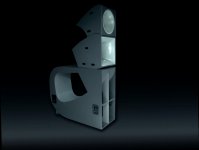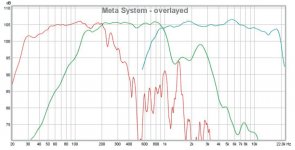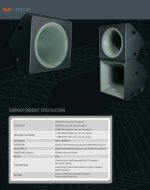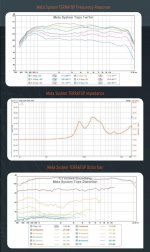These guys also build an impressive-looking 3-way mobile horn system, including a rather large 40° OSWG.
- 630Hz Oblate Spheroid with LeCléac’h roundover
- Crossover: 957Hz, LR24dB HP
- (HxWxD): 550mm x 610mm x 576mm.
- 630Hz Oblate Spheroid with LeCléac’h roundover
- Crossover: 957Hz, LR24dB HP
- (HxWxD): 550mm x 610mm x 576mm.
Attachments
Last edited:
Despite the narrow coverage angle and generous size, it seems this waveguide would put a quite lot of stress on the driver <700Hz.
Interestingly, a Fc of 630Hz is specified.
Interestingly, a Fc of 630Hz is specified.
Last edited:
Interesting assertion by Hodgson & Underwood:
"For an infinite length exponential horn with area A=AOe^mx, below the so-called cut-off frequency, f0=mc/(2π), propagation cannot occur, the diaphragm producing "sloshing" or reactive motion."
"For an infinite length exponential horn with area A=AOe^mx, below the so-called cut-off frequency, f0=mc/(2π), propagation cannot occur, the diaphragm producing "sloshing" or reactive motion."
Last edited:
It doesn't mean as much as it seems.
IMO it doesn't matter much at all.
Interesting assertion by Hodgson & Underwood:
"For an infinite length exponential horn with area A=AOe^mx, below the so-called cut-off frequency, f0=mc/(2π), propagation cannot occur, the diaphragm producing "sloshing" or reactive motion."
This is an artifact of the erroneous Webster's Equation. It does not occur in reality.
There are two approaches to "horns": Webster's and the Wave Equation. The Wave Equation is exact and Webster's suffers from seriously wrong assumptions. The two do not predict the same results. In the wave equation there is no such thing as "cutoff" in the sense described in this comment. It does not happen.
In the one or two cases where Webster's approach matches the Wave Equation, cutoff does not happen.
In order to clarify a few matters, let us set aside the principle of "cutoff" for a moment and focus on "loading characteristics".
According to Bjørn Kolbrek:
"The work of Earl R. Geddes on the Oblate Spheroidal Waveguide, earlier analyzed by Freehafer and Salmon is an interesting exception. Geddes first presented his work in an AES preprint in 1987, which was later made into a JAES paper in 1989. Geddes abandoned the earlier question of horn theory, “what is the loading characteristics of a specified horn contour?” and instead asked the question “what horn contour is required to yield the desired performance?” He sought the answer to this question in finding a one-parameter solution to the wave equation in separable coordinate systems, and adopted the oblate spheroidal (OS) coordinate system as a good candidate, as its coordinate surfaces produce a suitable horn shape."
Furthermore, in Introduction to horn theory, Kolbrek explicitly states:
"THE PURPOSE OF A HORN
It can be useful to look at the purpose of the horn before looking at the theory. Where are horns used, and for what?
Throughout the history of electroacoustics, there have been two important aspects:
• Loading of the driver
• Directivity control"
And:
"The greatest disadvantage of the OS waveguide is that it is not suitable for low-frequency use. Bass and lower midrange horns based on this horn type will run into the same problems as conical horns: the horns become very long and narrow for good loading. To sum up, the OS waveguide provides excellent directivity control and fairly good loading at frequencies above about 1kHz."
According to Bjørn Kolbrek:
"The work of Earl R. Geddes on the Oblate Spheroidal Waveguide, earlier analyzed by Freehafer and Salmon is an interesting exception. Geddes first presented his work in an AES preprint in 1987, which was later made into a JAES paper in 1989. Geddes abandoned the earlier question of horn theory, “what is the loading characteristics of a specified horn contour?” and instead asked the question “what horn contour is required to yield the desired performance?” He sought the answer to this question in finding a one-parameter solution to the wave equation in separable coordinate systems, and adopted the oblate spheroidal (OS) coordinate system as a good candidate, as its coordinate surfaces produce a suitable horn shape."
Furthermore, in Introduction to horn theory, Kolbrek explicitly states:
"THE PURPOSE OF A HORN
It can be useful to look at the purpose of the horn before looking at the theory. Where are horns used, and for what?
Throughout the history of electroacoustics, there have been two important aspects:
• Loading of the driver
• Directivity control"
And:
"The greatest disadvantage of the OS waveguide is that it is not suitable for low-frequency use. Bass and lower midrange horns based on this horn type will run into the same problems as conical horns: the horns become very long and narrow for good loading. To sum up, the OS waveguide provides excellent directivity control and fairly good loading at frequencies above about 1kHz."
Last edited:
Introduction to horn theory, Kolbrek explicitly states:
"THE PURPOSE OF A HORN"
• Loading of the driver
It depends on what have to be loaded, the air or the driver ?
Apparently, Bjørn himself is still comitted to "loading characteristics"...

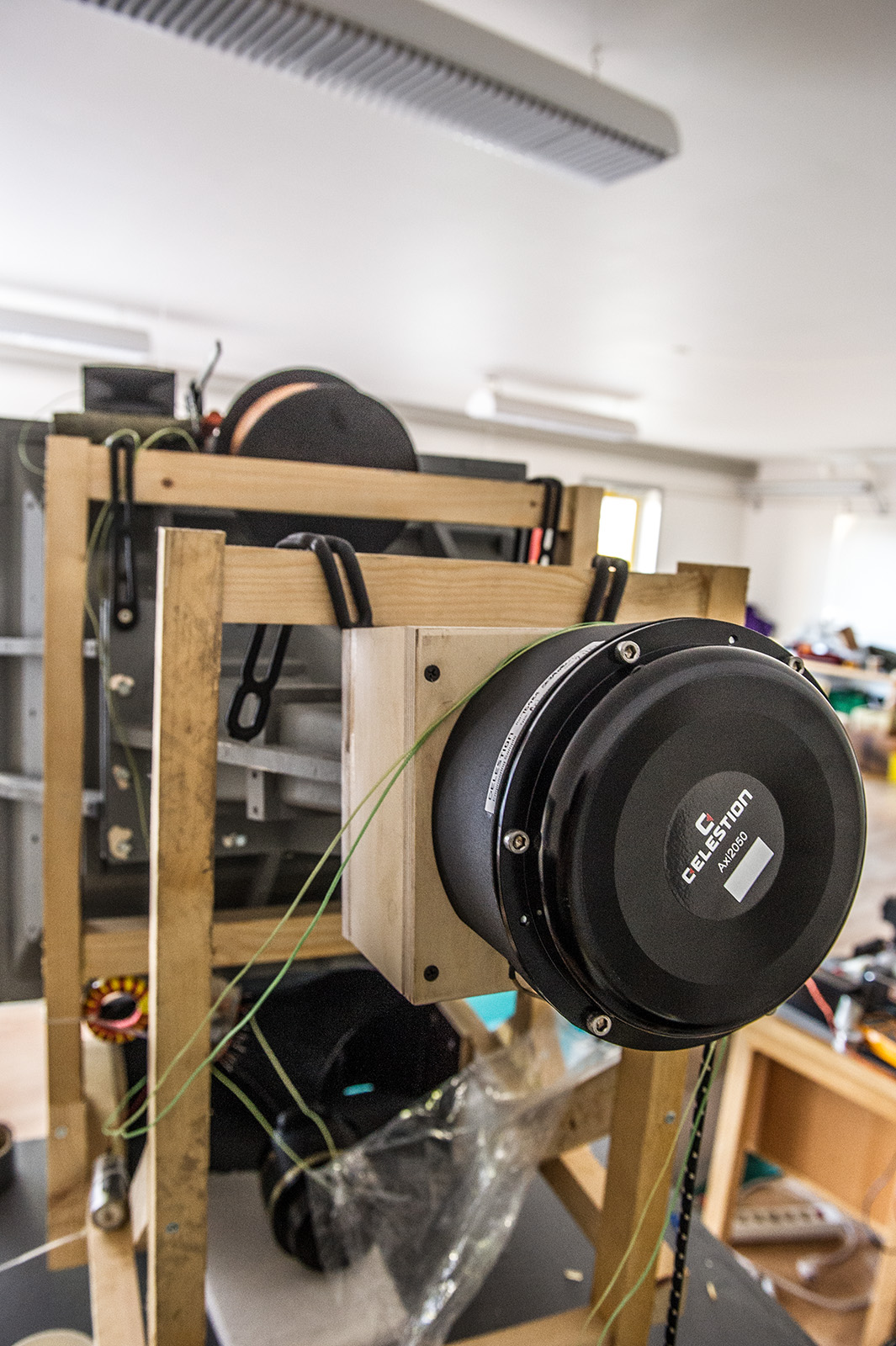
Then his 15" bass driver isn't "loaded" with such a horn 😛😛😛
This rectangular device between Axi2050 and the horn - is this a pre-chamber with a distinct volume?
This rectangular device between Axi2050 and the horn - is this a pre-chamber with a distinct volume?
Is that really a box? Why would you send the HF from a compression driver into a mini echo chamber and then to the horn? I can see a back chamber but not that.
Rob 🙂
Is that really a box? Why would you send the HF from a compression driver into a mini echo chamber and then to the horn? I can see a back chamber but not that.
Rob 🙂
I'm thinking it's a longish throat matching chamber, that was just convenient to build inside a box.... spitballing 🙂
I'd like to correct a couple of misleading comments of Bjorn.
An OS waveguide is no different from any other contour in this respect. I could design an OS that "provides excellent directivity control and fairly good loading at frequencies above" 500 Hz, or 250 Hz, or whatever frequency that one wants - it's just scaling. Sure it will be big, but then ANY horn operating down to these frequencies will have to be big in order to "provide excellent directivity control and fairly good loading." This situation is universal and yet Bjorn's comment makes it sound like it is unique to OS.
The OS waveguide is not a 1P solution. This was clearly pointed out in my original paper. I also pointed out in that paper how there are only a few coordinates that allow an exact solution from Webster's Equation, which Putland later confirmed in his paper. So I was not seeking a 1P solution since I knew that one did not exist in general. I was seeking an exact solution that would yield a complete picture of the wavefront, which cannot be obtained from Webster's Equation.According to Bjørn Kolbrek:
"The work of Earl R. Geddes on the Oblate Spheroidal Waveguide, earlier analyzed by Freehafer and Salmon is an interesting exception. Geddes first presented his work in an AES preprint in 1987, which was later made into a JAES paper in 1989. Geddes abandoned the earlier question of horn theory, “what is the loading characteristics of a specified horn contour?” and instead asked the question “what horn contour is required to yield the desired performance?” He sought the answer to this question in finding a one-parameter solution to the wave equation in separable coordinate systems, and adopted the oblate spheroidal (OS) coordinate system as a good candidate, as its coordinate surfaces produce a suitable horn shape."
"The greatest disadvantage of the OS waveguide is that it is not suitable for low-frequency use. Bass and lower midrange horns based on this horn type will run into the same problems as conical horns: the horns become very long and narrow for good loading. To sum up, the OS waveguide provides excellent directivity control and fairly good loading at frequencies above about 1kHz."
An OS waveguide is no different from any other contour in this respect. I could design an OS that "provides excellent directivity control and fairly good loading at frequencies above" 500 Hz, or 250 Hz, or whatever frequency that one wants - it's just scaling. Sure it will be big, but then ANY horn operating down to these frequencies will have to be big in order to "provide excellent directivity control and fairly good loading." This situation is universal and yet Bjorn's comment makes it sound like it is unique to OS.
No not really, the directivity at LF near fc depends almost entirely on the mouth size. There is certainly little or no dependency on the horn shape.
If the "loading disappears" then there is no radiation so there is no directivity.
Ok, I took a driver in free space without baffle as 1:1.. or loading = 1 so to say. But I realise that was not precise or even correct?
//
Ok, I took a driver in free space without baffle as 1:1.. or loading = 1 so to say. But I realise that was not precise or even correct?
//
You mean a compression driver with no horn? That's not really a valid comparison since we are talking about the effects that different horns have, not horn versus no horn.
I'd like to correct a couple of misleading comments of Bjorn.
The OS waveguide is not a 1P solution. This was clearly pointed out in my original paper. I also pointed out in that paper how there are only a few coordinates that allow an exact solution from Webster's Equation, which Putland later confirmed in his paper. So I was not seeking a 1P solution since I knew that one did not exist in general. I was seeking an exact solution that would yield a complete picture of the wavefront, which cannot be obtained from Webster's Equation.
The Putland-part of the story was left out, because it's not directly related to the topic at hand:
"Oblate Spheroidal Waveguide
This horn was first investigated by Freehafer, and later independently by Geddes, who wanted to develop a horn suitable for directivity control in which the sound field both inside and outside the horn could be accurately predicted. To do this, the horn needed to be a true 1P-horn.
Geddes investigated several coordinate systems, and found the oblate spheroidal (OS) coordinate system to admit 1P waves. Putland later showed that this was not strictly the case. More work by Geddes showed that the oblate spheroidal waveguide acts like a 1P horn for a restricted frequency range. Above a certain frequency dictated by throat radius and horn angle, there will be higher order modes that invalidate the 1P assumptions. The OS waveguide does not have a sharp cutoff like the exponential or hyperbolic horns, but it is useful to be able to predict at what frequency the throat impedance of the waveguide becomes too low to be useful."
Last edited:
It could be concluded that:
- OSWGs provide superior performance, if uncompromised directivity is desired.
- If excellent loading of the driver is paramount, at the expense of directivity, a Salmon-
horn is a viable option.
- OSWGs provide superior performance, if uncompromised directivity is desired.
- If excellent loading of the driver is paramount, at the expense of directivity, a Salmon-
horn is a viable option.
Better low frequency directivity control should mean less power needed at those lower frequencies. What good is the loading if a more curved horn is just going to throw it away?
If excellent loading of the driver is paramount, at the expense of directivity, a Salmon horn is a viable option.
Please define excellent loading and what the differences are between a salmon and a OSWG that makes the salmon superior as far as loading.
Seems to me I see loading as a criteria but frankly don't see any clear reason why loading would be preferred over directivity control over the usable bandwidth.
Rob :}
- Home
- Loudspeakers
- Multi-Way
- Is it possible to cover the whole spectrum, high SPL, low distortion with a 2-way?
